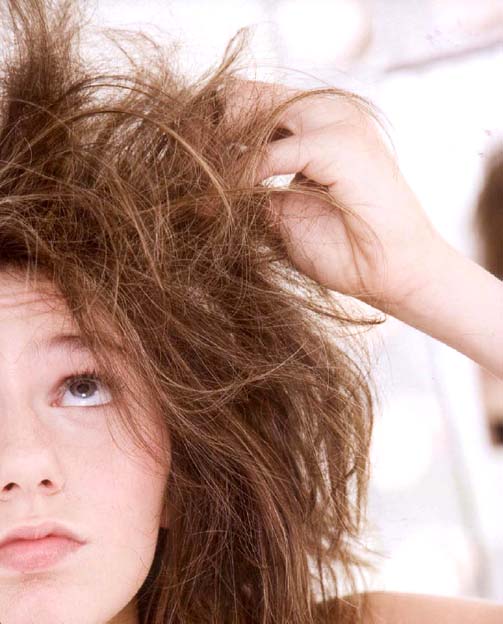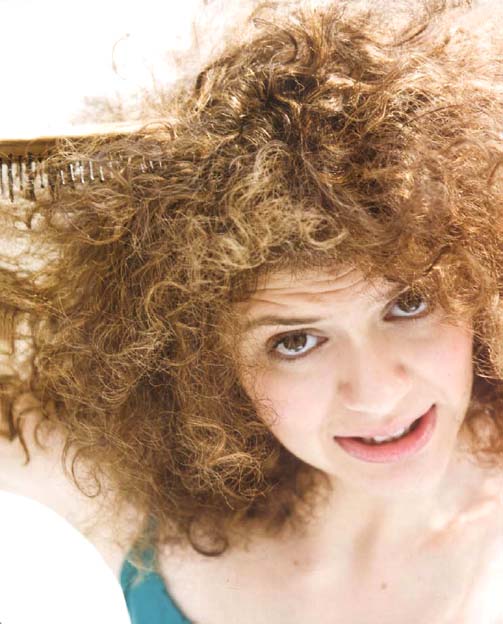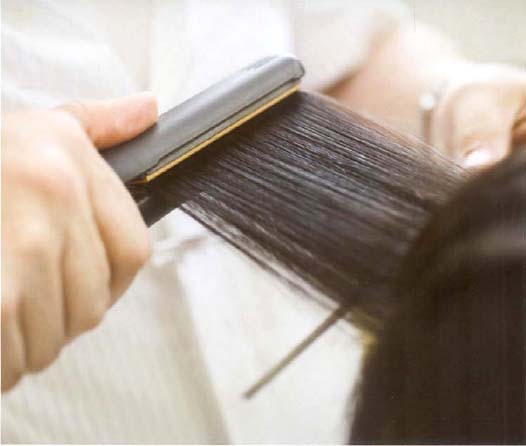7. Problem Hair and Maintenance

I’ve come across all types of problem hair over the years. From wild, flyaway hair, to thick, unmanageable locks, to out-of-control curls—you name it, I’ve seen it. I’ve also seen clients with all types of troublesome hair making some of the most adventurous requests of their hairdressers, requests that would definitely make you laugh—or cry.
I’ll never forget the woman with thinning hair—50 percent of it was already all gone—who wanted a long, flowing, and shapely Farrah Fawcett style. What could I say? “Sorry, love, but you’re never going to look like a Charlie’s Angel,” was my opening gambit!
When I first moved to New York, the “Rachel" (Jennifer Aniston’s haircut from the early days of Friends) was oh-so-hot-to-trot. But it wasn’t right for everybody, especially the woman with superthick, supertight spiral-shaped curls who politely asked me to make her look “just like Jennifer.” “Absolutely, love. Now where did I put that nuclear-strength straightening iron?”
This isn’t the right way to start every consultation, but sometimes a gag, or a loose, casual, and jokey tone helps break the ice with a nervous or unsure client. I use what I need to, even the cheeky side of my personality, to help me and the client get where we need to, especially when the client has real problem hair and is having trouble facing reality.
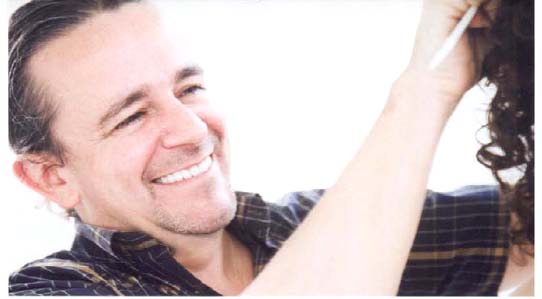
The reality is this: If you have extreme natural frizz, supertight curly hair, sun-damaged or overprocessed hair, thinning hair, or extrathick wirelike hair, then styling your hair can be a real battle. I say “can,” because it doesn’t have to be that way. You know by now that my philosophy is to choose styles, techniques, and products that are going to work for your hair type, because this makes it much easier to achieve quick and easy success from day to day. If you have problem hair, you need to be even more committed to following these guidelines. Your options are more limited, because, as your hair is so extreme, the more you try to take it away from its natural state, the more unmanageable it becomes. That’s why I had to start those two lovely ladies off with a joke. I had to get them back to reality because they were asking for styles that were so far removed from what they could easily achieve that their hair would have turned into a real nightmare. Maybe if I had summoned all my experience and skill, I could have got somewhere near the styles they wanted, but they would have looked totally unnatural, and day-to-day styling would have certainly driven them to drink.
If you have problem hair, there’s little point in cursing your rotten luck. Your hair is what it is and it’s part of who you are. Besides, remember what I said in the beginning: Even the most crazy, wild, out-of-control hair can look gorgeous if you start with the right cut and then use the right products and techniques to retain the integrity of your hair. Be realistic about what your hair can achieve and accept that there are certain maintenance routines that you need to adopt, and I promise you healthy, sexy, minimal-fuss hair that is sure to make you one hot mama.
Now let’s talk about how to maintain and style all kinds of so-called problem hair. I’ll recommend some haircuts from my style guide that will be the best fit for you.
Extremely Frizzy Hair
Extreme natural frizz normally occurs in hair that has a tough, coarse texture. The hair is usually very dry and very curly (although, rarely, extreme natural frizzy hair can be seen in straighter hair types). It’s also common in gray hair, because as hair ages and becomes increasingly gray, the texture grows increasingly coarse and frizzy. Your primary difficulty is managing your hair from day to day because even moisture-based leave-in conditioners or curl and styling crémes are likely to leave your hair dry, frizzy, and separated with no true sense of style.
Your number one priority is to get the right haircut. A strong (rather than a soft) shape is much easier to maintain on a daily basis. The round two and a half inches (here) or any cut that is short to midlength with a good solid shape perfectly suits extremely frizzy (either curly, straight, or gray) hair. These cuts don’t alter your hair texture, but the strong shapes get you looking polished and pulled together, and controlling frizz is much more manageable, making your styling quick and simple.
When it comes to styling, a silicone-based defrizz serum should become your best friend. If you’re curly and frizzy, use the smoothing properties of silicone defrizz along with a moisture-based grooming or curl créme to lock in curls without the dryness and without the frizz. You should definitely try my controlled curls styling technique here. Master this technique on a strong-shaped haircut and you’ll have an easy frizz-free look you’ll love. If you’re one of the rare straight-hair frizzies or have gray hair with extreme frizz, I recommend using a defrizz serum with a styling créme or smoothing lotion to slick the hair down. Try the smooth blow-out styling technique highlighted here. Curly, straight, or gray superfrizzy types can also all try the wraparound technique illustrated here—all hair is smoother when you use this brilliant and easy technique.
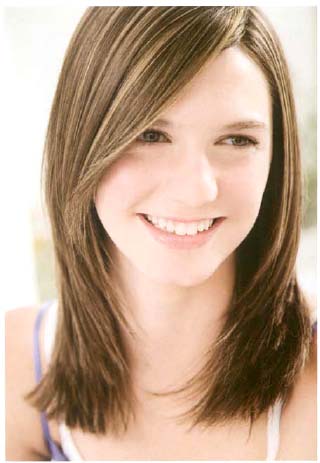
My top-tip method for adding moisture to dry, frizzy hair is a bit of an old salon secret that has unfortunately been nearly forgotten over the years. I’ve yet to see any newfangled trick or product work as brilliantly as this very effective technique: Once a week, pack a hairnet with a light leave-in conditioner. Use three to four times more product than normal and put the hairnet over your wet to damp hair for ten minutes. This is a great way to lock the moisture-giving benefits of the product in to the hair shaft for added support. After ten minutes, take off the hairnet but avoid the temptation to rinse out the product—leave it in. Your hair will be richly moisturized, soft, smooth, shiny, and have more malleability, making it much easier for you to style. You can even add a little styling créme into the hairnet mix to give your hair added textural support for styling.
Finally, when you’re not packing your hair with leave-in conditioner, you should regularly use a moisturizing shampoo and moisturizing conditioner that penetrate into the hair shaft. This gives your hair essential day-to-day moisture support.
Extreme and Unmanageable Supercurly Hair
Supercurly hair shrinks up into tight ringlet-style spirals. It looks dense and it’s difficult to see the definition of your curls because they’re packed so tightly together. The hair texture can be either very fine or very thick, but the density is generally very heavy. The combination of a very rounded curly hair shape and a dense head of hair makes most people with this hair type feel like there’s nothing they can do.
Get the right haircut and there’s a lot you can do. You need a cut that celebrates the curl. A shorter cut (especially if your hair likes to puff up and out, which is likely if the texture is thick) that creates pieciness and separation in the length is your ideal. One of my favorites is the rounded graduation (here), and you can also try the round one inch (here) and the round two and a half inches (here). These cuts give you greater dimension, your look will be strong, and it will be easier for you to control your hair.
A great, easy styling idea is to blow-dry the front straight. Just apply a defrizz serum to damp bangs and blow-dry with a round brush on mid-to-high heat. In about two minutes your hair will be smoother and more polished in the front, while the rest of your hair remains naturally curly. Just make sure you create a nice even blend of the straighter shape at the front and the more curly sections at the back, and you’re golden. And because you’re styling only your bangs, this technique is quick and simple. The rest can dry naturally—although I advise scrunching in some leave-in conditioner to the tips, just to soften them up.
To get shapely curls all over, you can use my controlled curls styling technique (here). If you prefer to go straighter and smoother, use a defrizz serum, the high heat of a blow-dryer, and a boar-bristle brush (the most effective smoothing brush) with my smooth blow-out technique (here) to flatten out and soften up your hair as much as possible.
Whether your supercurly hair texture is fine or thick, you don’t need to shampoo your hair nearly as much as you need to condition. Your hair is much better off if you get into the rinse-and-condition habit, rather than the shampoo-and-condition habit. Don’t worry about dirt; the oils from your scalp don’t run through this hair type so much because it’s so dense, and whatever natural oils do come through actually aid your natural texture and make your hair more manageable. Using a moisture-rich conditioner is, on the other hand, essential. Extremely curly hair is almost always dry, and you need that added moisture to fight the frizz. As a general rule, shampoo once a week, condition each and every day.
Sun-Damaged Hair
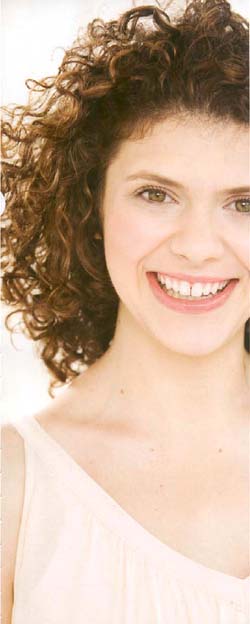
The heat of the sun’s rays has the power to cause damage. It can cause tangles, make split ends more noticeable, and cause color to fade. Ultimately, you’ll be able to feel how dehydrated, damaged, and brittle your hair has become.
Of course, my best advice is to prevent your hair from becoming sun damaged in the first place. Whenever you’re in the sun, you should protect your hair the same way as you protect your skin. Nowadays, you can find shampoos, conditioners, and styling products with UV protection in your local hair salon or beauty supply store, and you should use one or more of these products for any extended periods of time in the sun.
Even better, wear a hat or scarf. These can look supercool, and covering up is the best sun-protection method there is. Also, remember that if you’re vacationing, you can wear your hair more casual than usual. There’s no need to blow it out so often, thus subjecting it to heat stress as well as sun stress. Pull it back into a low pony and you’re good to go. The added glow the sun gives your skin means you don’t have to rely so much on your hair to add that final polish to your look, not to mention the fact that your vacation should be about being laid back and having a good time, not about hair styling.
If you’re on vacation, there’s a good chance you’ll be near the sea, and the salt water it’s filled with, so let’s talk about that, too: Salt water does put some interesting and pretty-looking textures into your hair, but it’s also extremely drying and likely to cause damage, especially when combined with the sun’s heat rays. If you’re heading into the ocean, remember these two words: moisturizing conditioner. Normally you rinse out moisturizing conditioner, but on this occasion, leaving a moisture-based conditioner in your hair before bathing in salt water—or, indeed, chlorine-filled water—gives you an essential moisture-filled barrier of protection.
If your hair has already been shattered by the sun, a deep-conditioning, keratin-based treatment can help (see “Overprocessed Hair" on the following page for more details on this). But if the ends are truly split, get a cut. It’s the only way to get back your hair’s health and luster.
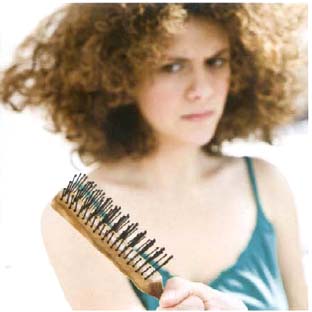
Humidity Hair
In England, humidity hair is not really much of a problem, and I heard very little about it until I made my move to the States, where the hot, sticky summer climate definitely does cause real problems, especially for curly hair. That’s chiefly because curly hair is the driest hair type, and dry hair is attracted to the added moisture in the air. This can cause unwanted and unruly fullness and frizz for anyone whose hair is on the dry side (which can include straighter hair types as well). The problem is that when your dry hair attracts the extra moisture in the air, it begins to swell. If you don’t do anything to protect yourself, the humidity makes your hair expand, expand, and expand until any styling you’ve done goes by the wayside and is replaced by uncontrollable volume, or curl, or frizz, or, in some cases, all three.
If heat-humidity is causing problems for you, here are some steps you can take to minimize its effect on your hairstyle:
First of all, throughout the hot summer months, switch to a rich moisturizing, hydrating, or clarifying conditioner. The added moisture these types of conditioners put into your hair helps keep the added moisture in the air from seeping into the hair shaft. How? Simply put, if your hair has enough moisture in it to begin with, it will not swell up looking for the additional moisture in the atmosphere.
If your hair is straight to moderately wavy, it’s also essential to use a high-quality defrizz serum that fights the frizz throughout the day. Remember, with defrizz serum, you focus the application from the midlengths to the ends, and you also need to blow-dry on a high heat to get the maximum benefits from the product. Curly hair types should focus on the controlled curls styling technique here. This gives you beautifully defined curls that stand a great chance of holding up to the humidity. And for both curly and straighter hair types that suffer in the humidity, it’s essential to put a moisturizing styling product in your purse and carry it with you all day. You can use a leave-in conditioner, a moisture-based hair créme, or a hair refresher when you feel your hair starting to puff up and out. Just apply a small pea-sized amount of the product to the hair to add moisture. This freshens up your hair and provides a layer of protection to fight the humidity.
Also, it’s vital on days like these that you don’t fight your hair too much. If your hair is straight, wear it straight rather than trying to make it wavy or curly; if your hair is wavy, wear it wavy rather than trying to make it straight or curly; and if your hair is curly, wear it curly rather than trying to make it straight. I say this because humidity tends to return your hair to its natural state, so trying to fight it by styling against your natural shape and texture only makes it much, much worse. Keeping it natural gives you the best chance to maintain a humidity-free look.
Finally, I will talk about ionic technology later in this chapter, which is something you should definitely investigate for yourself. Ionic styling tools stand up better to humidity than their traditional counterparts.
Overprocessed Hair
Overprocessed hair has been put under heavy stress. Signs of overprocessing include hair that is falling out at a rapid rate, dry, brittle hair, and split ends. These problems stem from too much chemical color work, too much permanent waving, and/or too much straightening or curling with a hot iron.
Hair like this needs lots more care and lots more moisture to get it back into tip-top shape. Use a rich moisturizing shampoo and conditioner to pack in the moisture and take extra time to condition your ends thoroughly. Use moisture-based styling products like crémes and lotions as well and be extra careful with your hair every day. Stay away from extensive blow-drying and heat tools whenever possible because they add more stress.
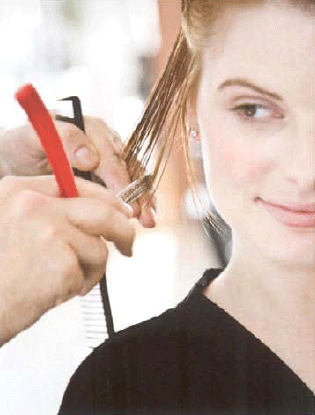
I also recommend a once-weekly keratin-based treatment. (I recommended this as a method of prevention, too, especially if your hair isn’t overprocessed yet, but you like to go to town with your heat tools.) Keratin is a strong, tough protein, and it’s a major component of your hair shaft. So when the keratin dies away, as it does especially quickly in overprocessed hair, your hair becomes increasingly dry and brittle. Adding layers of keratin builds protein-filled molecules in your hair shaft. It won’t make your hair feel soft and silky, but it will strengthen it, and that reduces breakage. If you feel your hair could do with this type of strengthening, ask your salon stylist to recommend the right keratin-based products for you.
Another problem with overprocessed hair is that it’s difficult to color successfully because your hair becomes like a fragile fabric and the color molecules just don’t lock properly into the hair shaft. The chances of a successful color service decrease tenfold on overprocessed hair. If you’re in this overprocessed scenario but feel in desperate need of a new style-defining hue, the best thing to do is get a trim before you get the color. Damage in overprocessed hair always begins at the tips of the shaft because that’s the oldest part of your hair. In fact, hair never gets damaged in the middle or at the roots before it gets damaged at the ends. Cutting off most of the damage (rarely does the damage spread far up the hair shaft) allows your bright new color to take full effect.
Finally, I recommend that anyone with overprocessed hair get a cut or trim, even if you’re not thinking of a color service. This is the best way to get back the vital healthy-looking luster that makes any shape or style look so much better.
Thinning Hair
Thinning hair is a problem for many women. The thought of major hair loss is, understandably, a subject of much worry and angst, but before you panic, remember these few simple things:
Hair loss can be sporadic, and there are times when we all go through more shedding than usual. Typically, new hair follicles grow in every seven years, replacing the older ones. Anytime you start to shed more hair than normal, it may well be a part of your natural cycle.
Postpregnancy, a lot of women encounter hair loss. The most common period of hair loss occurs around three months after delivery. The rise in hormones during pregnancy keeps you from losing your hair. After delivery, the hormones return to normal levels, which allows the hair to fall out and return to the normal cycle. The normal hair loss that was delayed during pregnancy may fall out all at once, causing worry about long-term thinning of the hair. However, between six and twelve months after giving birth, hair growth returns to normal.
With longer hair and curly hair, the typical hundred hairs a day that fall out of everybody’s hair often get trapped in the scalp and come out only when you wash or brush your hair. So if you see lots of hair on your brush or in your shower, it may well be residual fallen-out hair.
Stress, health, and diet all play a part in thinning-out hair. So eat healthy and be well for thick luscious locks!
Medical hair-growth treatments can and do work for some, but to keep up the hair growth you have to keep up the treatments for life. So before you start down this road, be sure that you are prepared for the lifelong commitment.
It’s very, very rare for a woman to look truly balding without having alopecia. Alopecia is a medical condition that requires treatment by a physician. Otherwise, baldness is something for men to worry about, not you.
Nobody’s hair is as thick as it was in her youth. As we age, we get wrinkles and our skin loses its elasticity. And as we age, our hair begins to thin out, too.
Having said all that, if your hair is anywhere between superfine and floppy to noticeably translucent, your focus should be on getting a shorter, more textured hairstyle. This is, without a doubt, essential for thinner hair types. If your hair is thin in density, fine, and light, a short haircut allows the hairs to sit on top of one another and gives you that vital illusion of thickness (as opposed to a long hairstyle, which hangs straight down and consequently appears even finer and thinner). You’ll lose that feeling of thin hair, and you’ll be more comfortable with your locks. Layering your short hair adds to the illusion of thickness. Try the light face-frame cut (here), the bob cut (here), or the shag cut (here)—all are short enough to allow your hairs to sit happily on top of one another. Go for bangs, too. This allows you to style your hair forward instead of brushing it back. Bringing your hair forward is another excellent way to give the illusion of thickness; brush or slick it back and thinness becomes much more visible.
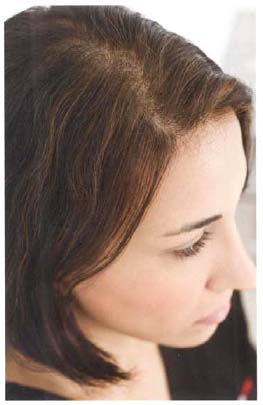
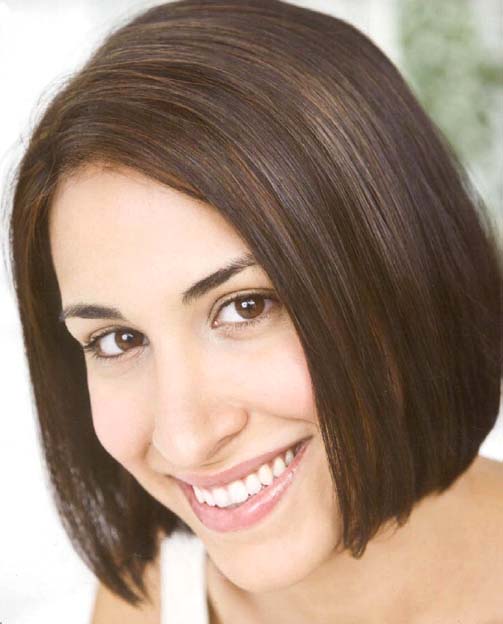
To cleanse and condition really fine hair, use the lightest daily shampoo and the lightest daily conditioner you can find. Thicker moisturizing products weigh your hair down into a flat and floppy look. There are now shampoos and conditioners on the market labeled “volumizing,” “thickening,” or something similar. The intention is to puff out the hair molecule for fullness. Results vary from person to person, but they are worth a try. If this new technology works for you, great, but whatever shampoo and conditioner you use, you need only a bit. That’s especially true with conditioner, because too much makes your fine, fragile hair too soft and unable to maintain any style-defining structure. And remember to rinse out cleansing and conditioning products extra well. Any residue on such fine hair weighs it down even more.
For styling, volumizing foam is your number one go-to product. This helps you to build density, texture, and dimension. But remember, finer, thinner hair doesn’t need too much product; again, it weighs it down. Apply a small amount at the roots and blow-dry using the volumizing technique (here); this is a great way to add more thickness, structure, and volume to any hairstyle.
People with thinner hair types also need to be careful with hair color, especially if your hair is so thin that it is translucent through to the scalp. Why? Because your scalp has a light hue, and a dark hair color provides a contrast that showcases the prominence of your scalp. On the other hand, a lighter hair color helps to disguise any see-through areas.
Extrathick, Coarse, and Wirelike Tough-to-Manage Hair
People with extrathick wirelike hair have up to three hairs in each hair follicle and are also likely to have a lower hairline—one that encroaches on your forehead and sits low down on the nape of your neck. It’s infuriatingly tough to manage hair like this because it’s so dense, thick, and coarse that it’s difficult to get a brush or product to go through the hair.
Once again, the cut you get is all-important. Go for a style two inches or shorter in length with lots of texture, and it’s much easier to control your hair. Or choose a shoulder-length or longer style and let the added weight help pull your hair straight down, also making it easier to manage. Additionally, with a longer style, you can pull your hair back into a ponytail, which, of course, is something anybody can do. For a shorter cut, try the cropped razor cut (here) or the graduated razor cut (here). Or, to go longer, the two long layered cuts make your day-to-day styling that much easier.
You need the right products, too. Oil-based, moisture-rich styling crémes and lotions make managing your hair easier. To smooth it out, blow-dry using a defrizz serum with a flat paddle brush. Or substitute a straightening iron for the flat paddle brush for maximum smoothness and softness. (Remember the one bonus of thick coarse hair: It’s so strong and so tough that it can take lots of heat tools without becoming damaged.) Read over my instructions for the smooth blow out (here) and flat iron forward (here). With either technique, the heat helps to press your hair flat, leaving it straight and smooth, which is exactly what you want to achieve with such thick and puffy hair texture.
This is another hair type that you should refrain from shampooing too much. Even shampooing once every two or three weeks is enough because the natural oils from your scalp don’t run through your hair (because it’s so thick and dense) and make it dirty as they do in other hair types. Besides, very clean, coarse hair puffs up and out more, the opposite of what you want. Focus on conditioning instead. Use a deep or moisturizing conditioner thoroughly and often to condition the midsection through to the ends of your hair. Extracoarse hair is typically very dry, so adding moisture instantly makes it easier to shape and define your style because your hair is that much more malleable.
Rarely, when the hair texture is unbelievably thick and dense, no amount of moisture-based conditioners, defrizz serums, or heat tools can make the out-of-control, unmanageable thickness go away. I sympathize—this can cause a lot of heartache. The best thing you can do is invest in thermal reconditioning. This is normally how ethnic hair types “relax" their own unique and challenging hair, but it also smoothes out extrathick Caucasian and Latina hair. It costs a lot—between $500 and $1,000 per treatment—and you need to keep it up (twice a year, in most cases), but it leaves your hair permanently flat, smooth, and straight (only your new growth hair continues to grow back in a thick, unmanageable way). Never do this on fine or overprocessed hair—it’ll just break off. I absolutely insist that you go to a true expert with extensive experience in the field, because even on strong, thick, and coarse hair, if it’s done incorrectly your hair will break off. No cheap tricksters or charlatans, please! (To find out more about thermal reconditioning, go to here.)
All Other Problems
If you’re free of all the specific problems outlined in this chapter, and yet you still feel like you’re fighting your hair, then you should take a fresh look at yourself. Go to your hairdresser and ask what’s the best look you can achieve with the minimal maintenance and styling effort. You may also want to consider making an additional investment by going to see a highly skilled and experienced professional. The art director, education director, or salon owner of a locally or world-renowned salon may cost that much more, but if you go only once, it may be worth it. Ask the professional for his or her expert advice and then get a great cut that you love and can maintain and style easily. After the first great cut, you know what works for you and are in a better position to ask another, less expensive stylist to repeat, or come close to repeating, the same style.
With the help of this book, I hope I’ve shattered the bad-hair day myth. Still, we all have days when bits of hair tend to defy our every styling attempt. On days like these, use accessories such as pony bands, bobby pins, clips, and grips to keep hair in good working order. I love these devices; they’re incredibly feminine and can accessorize any look perfectly, while also helping to tame any problem areas. (If you need more help on how to use these accessories best, then have a fresh look at “Pin Basics” and “Pin Perfect”.)
Maintaining Gorgeous Hair for All Hair Types
Aside from the specific cuts and techniques I’ve outlined for successful style in all types of problem hair, I want to give you general guidelines for gorgeous, healthy hair no matter what your hair type. And I also want to talk about certain products and tools that have huge benefits for day-to-day styling.
Great Hair comes from working with the natural texture of your hair, getting a great cut that’s a match for you and your hair texture and shape, the right shampoo and conditioner regimen, and easy, effective styling using the proper products and tools. I love working with hair, and I hope, with the help of this book, you will, too. Have a blast finding out how different styling techniques and different products work for you, but keep your hair free from abuse. Go easy on the heat tools, and when you do use them, take precautions (see “Thermal Protectors,” below). Stay away from blow-drying on high heat unless that’s absolutely necessary for you, and buy heat tools with a temperature gauge and use it to keep the temperature as low as possible.
THERMAL PROTECTORS
A thermal protector spray, lotion, or créme is essential for anyone who regularly uses heat tools. It massively reduces the damage to your hair by forming a protective barrier against the heat. You still need your existing styling product (volumizing foam, styling créme, defrizz serum, and so on), and the best way to apply is to mix the thermal protector with your chosen styling product (unless it’s a thermal protector spray, in which case it’s easier just to spritz it straight on to your hair before you apply the product or use a tool). In addition, there are some new thermal protectors on the market that mix styling benefits along with heat protection. Feel free to give these a try to see how they work for you, but personally, I prefer specific products for specific jobs—if they need to be mixed with other products to get the right effect, no problem.
ADVICE FOR HEAT-TOOL USE
Heat tools like curling and straightening irons are a great addition to your styling arsenal because they allow you to shape and style your hair quickly and easily—a perfect solution to our time-challenged lives, especially since they’re so wonderfully effective. The price you pay, however, is heat-induced damage to your hair. Sure, you look great today and tomorrow, but constant use can and does cause real damage to the hair shaft. When that happens, it’s really tough to get your hair looking good, no matter what cut you have, or what product or tool you are using. I’ve already talked about how thermal protectors are essential if you want to use heat tools regularly, but I want to give you some additional tips and techniques that can minimize the amount of stress you put on your hair:
When using a curling or straightening iron, take thicker sections of hair into the iron all at once. This means heat is being applied directly to fewer individual hair strands, reducing the amount of heat stress in the process. Take finer sections and you subject your hair to more heat and more stress.
Another great way to diffuse that stress-inducing heat: Keep your heat tools moving as much as possible, no more than fifteen or twenty seconds before moving on to the next section.
Buy irons that have a thermometer gauge and keep your heat tool on the lowest setting possible. Yes, a superhot iron makes your hair straight and smooth right away, but do it a lot and you soon encounter dried-out, frazzled hair that never will be smooth and straight again until you cut off the damage.
Remember, if you use heat tools often, the damage can make it more difficult to achieve a successful color service. That’s because the cuticle can become dry and damaged and won’t open up as much when color is applied. This means the color fails to lock into the hair shaft as well, reducing the short- and long-term effect of color. If you use a lot of heat tools and you’re going in for a color service, be sure to let your stylist know so he or she can compensate for it in the color process.
As a general rule, avoid subjecting your hair to excessive heat whenever possible. A well-executed straight blow out lasts you three days. And it’s likely to look even better on the second or third day because your hair will be less susceptible to frizz and flyaways. So there’s no need to blow-dry every day. If you’re curling your hair, remember that rollers are a superb way to introduce brilliant, bouncy curls without the heat of a curling iron (see here for more details).
IONIC TECHNOLOGY
Available in brushes, blow dryers, and straightening irons, ionic technology is a powerful hair-styling aid that’s been on the market for a few years. Tools with this technology are grabbing a large share of the market, and with good reason—the right ionic tools are even easier and quicker to use than traditional tools; they add shine and strength, reduce static and frizz, and leave your hair feeling soft, smooth, and shiny. Personally I love them, and I’m using ionic tools more and more in my salon.
So how does it work? The answer involves a bit of a science lesson, so bear with me. Ionic technology refers to the creation of negative ions or negatively charged particles. These negative ions are abundant in nature, particularly around water, and are known to have a good natural energy. A few years ago, it was discovered that this energy worked on the hair cuticle. So, very kindly, scientists and innovators found a way to transport these negative ions directly to your hair through tourmaline, a semiprecious crystal and a natural source of ion energy. In short, modern ionic technology in hair care features small amounts of tourmaline crushed and infused into styling tools as a very clever little ion generator.
Although ionic technology is a rapidly growing market, many people are afraid or unwilling to use the technology due to some common misconceptions. First, you can’t physically see these ions (although if you look close enough you can see the tourmaline). Because we can’t see them, the belief is that they’re not actually there and it’s a charlatan’s trick that doesn’t work. This idea is supported by the many cheaper, substandard, ionic tools on the market that don’t give the true benefits of the technology. That leads to the final reason ionic tools are not as commonly used as they might be: the cost. Proper ionic styling tools cost a lot (they do contain a semiprecious crystal, after all), so before you buy, you should know that it’s right for you.
Guide to Ionic Technology
Ionic tools cause your hair to become more compact, making the shaft smaller and tighter in diameter (by as much as 25 percent). This is great for chemically treated hair, medium to coarse hair, and curly hair, as it makes your hair shinier, smoother, soft to the touch, and easier to shape, style, and control. Ionic technology also protects color-treated hair from fading. But if you have fine to medium chemically untreated hair, ionic is not generally for you, because ideally you want to puff out the hair shaft for that vital illusion of thickness—the opposite of what ionic does. However, if your hair is fine to medium and your ends are brittle and damaged, then you can use ionic tools just on the ends where this technology helps to repair the stress. This all may sound too good to be true, and I can understand those sentiments, especially if you’ve never seen or heard of ionic before, but I’ve been using this technology in my salon for a couple of years now, and I wouldn’t recommend it if I didn’t feel it was up to the job.
Here’s what ionic technology does best:
• Tightens the hair cuticle for shine and smoothness
• Helps prevent fading in chemically treated hair
• Keeps hair soft (traditional heat tools can make hair brittle over time)
• Fights frizz and flyaways
• Speeds drying time
• Protects against the static and frizz induced by heat-humidity
• Helps maintain even levels of moisture throughout the hair shaft
Okay, now let’s look at how different ionic tools work, and what features and benefits they have for you.
Ionic brushes. If you’re unsure about laying out the money for an ionic dryer or a straightening iron, an ionic brush is a great place to start—you can buy a good one for less than $50. Most common on the market are flat paddle brushes and round bristle brushes. Use them the same way you use any other flat paddle or round bristle brush. How do they work? The brush bristles are infused with tiny tourmaline particles, and, as the brush rotates through your hair, the ions smooth out any roughness in the cuticle, helping you create perfectly groomed, frizz-free looks.
Blow-dryers. In ionic dryers, a tourmaline coating is added to the heat element or nozzle, and, as the hot air flows past the coated area, it carries the ion energy into the hair shaft. This causes the hair cuticle to constrict, in turn reducing the diameter of the hair shaft. A constricted (flatter, straighter, and smoother) cuticle reflects light better for shine; it helps protect against frizz and limp and lifeless hair, as well as the problems resulting from heat-humidity. Ionic dryers also dry your hair more quickly than standard dryers. That’s because as your hair is constricted, the water is being squeezed out. These dryers are expensive, thoug—around $200 for a good one.
Straightening irons. Here the tourmaline is crushed into the plates of the straightening iron, which comes into direct contact with your hair. Ionic straightening irons are used in the same way as more traditional tools—again, it’s just that they are much more effective at straightening, smoothing, and giving a high-gloss shine to medium-to-thick or chemically treated hair. And, crucially, ionic irons don’t cause heat-induced damage. Yes, this is still a hot tool, but the ions really do protect your hair, for the healthiest possible results. These irons range from a 1/2" barrel size up to a 2" barrel size. Just as with other hot irons, smaller barrels are great to get into tight areas, around the ears, nape, and neck, while bigger barrels flat iron bigger sections more quickly. Good ionic straightening irons cost between $100 and $150.
Problem Hair Q & A
In my salon, through snail and e-mail, and even on the street, I get stopped and asked for solutions to styling problems. It’s interesting because, mostly, the troubles I hear about cover the same ground. It seems everyone is baffled by frizz, fine or curly hair, and extrathick hair. So I’ve decided to tackle those typical questions right here, right now. If you encounter a similar problem, my styling solutions will be just the ticket.
My hair is very frizzy, curly, and extremely thick. I want my frizz to be transformed into beautiful shine. Can you give me some tips on what products and styling techniques to use to transform my look and calm my frizz?
Shampoo and condition your hair and towel-dry to damp. Apply a moisture-rich volume-building product like styling créme from the roots to the midsection of your hair shaft. Next, apply a defrizz serum from the midsection through to the ends of your hair shaft. Now execute the wraparound blow-dry technique (here) using high heat and a large round brush or a flat paddle brush until your hair is approximately 70 percent or 80 percent dry (more normal types dry through almost completely, that’s why here I recommend drying through 95 percent. Finally, apply a thermal protector product and use a straightening iron to flatten out the roots, paying particular attention to the back of your hair. Take half-inch sections and move through them quickly and easily. Finish with a touch of shine spray, which helps to press your hair flat and adds a brilliant dab of glitz and glamour to your look. You’ll have fabulously sexy, straight, and smoothed-out hair. Alternatively, if you’d like to celebrate your curls, do exactly the same thing, just substitute a large-barrel curling iron for the straightening iron and focus on shaping soft, frizz-free, bouncy curls.
I have naturally curly hair that is very fine and thinning. I would like to give the impression of fullness. How do I obtain fullness with my curly hair?
It’s easy! Shampoo and condition and then simply execute the controlled curls styling technique (here) with the products recommended for fine hair (a volume foam and a curl créme).
My hair is straight, thick, and coarse, and I can’t do anything with it. Do you have any tips or techniques I could easily try?
The first thing you need is the right cut. And if your hair is really maddeningly thick, coarse, and straight, you definitely need a shorter style with loads and loads of layers to make your hair easier to manage and control. I recommend the razor-cut graduation cut (here) or the cropped razor cut (here). Both are the short, manageable styles you need. You can even create magically smooth hair. Just apply the wraparound technique for smoothness as demonstrated here, with one simple change of product. Skip the volume foam and just use lots and lots of defrizz. Your hair doesn’t need the added volume, but it definitely does need the smoothing benefits of a serum.
On What Not to Wear, I saw you tame an African-American lady’s Diana Ross-esque hair. My hair is just like that. Could you please tell me the instructions and products used to do this technique?
This takes time, but it is a highly effective technique for creating shiny controlled curls, just like Diana. Start by applying a moisture-rich, volume-building product like styling créme or curl créme from the roots to the ends of wet to damp hair. Now, from the tips of your hair, grab a one-inch section, pull it taut and straight, then use your fingers to twist it around into a tight spiral. Take the spiraling all the way to your roots and then let it go. Now you can cup this one-inch section in your hands, push it toward your roots, and gently squeeze, squeeze, squeeze for thirty seconds. This locks in your curls, taming any unruly knots or frizz. You can do this in sections all over your head, but I advise focusing on the front and sides and not worrying so much about the back. These areas are much easier for you to work on because you can see what you’re doing, and it’s where you get the most definition. This look will last you all day. If you want a look to last you all week, use big rollers to reset the formation of your hair into a softer curl texture that you can manipulate into your own shape and style. (Take a look at Chapter 9, “Special-Occasion Hair" for more details.)
Summing It All Up
The biggest lesson you learned from this chapter is that tough-to-manage and troublesome hair have certain limitations in terms of its stylability. But face that reality and apply the right cut, product, or styling technique (and in many cases all three), and getting gorgeous-looking, easy-to-maintain hair should be no trouble at all.
Each type of problem hair has its own simple solution: If you have supercurly hair, get a short and rounded cut that celebrates the shape of your curls and then control those curls with a defrizz serum and a curl-enhancing product. If your hair is sun damaged or overprocessed, protect it from the elements with hats and scarves; repair it with deep-conditioning treatments; and if it gets really bad, simply cut off the damaged hair and let it grow back healthy and sexy. If you have fine to thin hair, get a short haircut that makes your hair look thicker, use light shampoos and conditioners that don’t weigh your hair down, and style your hair with a good volumizing product. If you have extrathick hair, go for a short haircut that takes the weight out, or for a long haircut that uses the weight to pull your hair down, straight and flat. If your hair suffers in heat and humidity, work with it in the most natural way. Use moisturizing shampoos and conditioners to put back essential moisture, then use a defrizz serum as your go-to styling product. And for all hair types, problem or not, you can take even more care by using my advice on thermal protectors, ionic technology, and the right way to use heat tools.
Commit to following these guidelines and your problem hair will be a problem no more.
